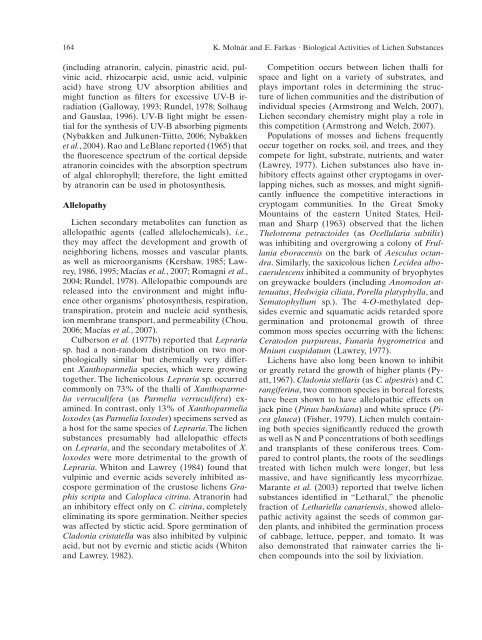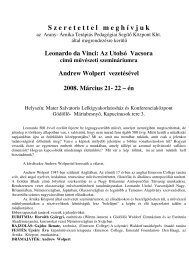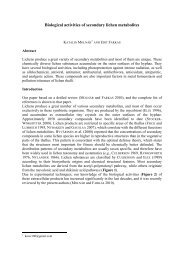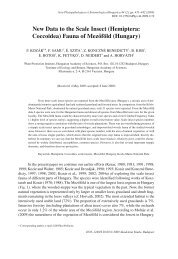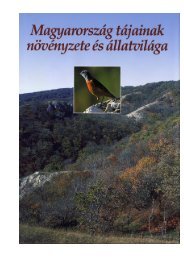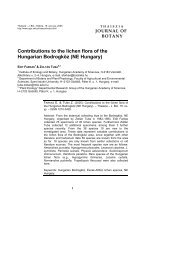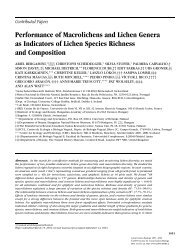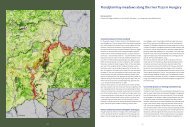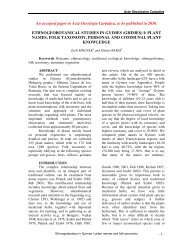Current Results on Biological Activities of Lichen ... - Lichens and Me
Current Results on Biological Activities of Lichen ... - Lichens and Me
Current Results on Biological Activities of Lichen ... - Lichens and Me
You also want an ePaper? Increase the reach of your titles
YUMPU automatically turns print PDFs into web optimized ePapers that Google loves.
164 K. Molnár <strong>and</strong> E. Farkas · <strong>Biological</strong> <strong>Activities</strong> <strong>of</strong> <strong>Lichen</strong> Substances<br />
(including atranorin, calycin, pinastric acid, pulvinic<br />
acid, rhizocarpic acid, usnic acid, vulpinic<br />
acid) have str<strong>on</strong>g UV absorpti<strong>on</strong> abilities <strong>and</strong><br />
might functi<strong>on</strong> as filters for excessive UV-B irradiati<strong>on</strong><br />
(Galloway, 1993; Rundel, 1978; Solhaug<br />
<strong>and</strong> Gauslaa, 1996). UV-B light might be essential<br />
for the synthesis <strong>of</strong> UV-B absorbing pigments<br />
(Nybakken <strong>and</strong> Julkunen-Tiitto, 2006; Nybakken<br />
et al., 2004). Rao <strong>and</strong> LeBlanc reported (1965) that<br />
the fluorescence spectrum <strong>of</strong> the cortical depside<br />
atranorin coincides with the absorpti<strong>on</strong> spectrum<br />
<strong>of</strong> algal chlorophyll; therefore, the light emitted<br />
by atranorin can be used in photosynthesis.<br />
Allelopathy<br />
<strong>Lichen</strong> sec<strong>on</strong>dary metabolites can functi<strong>on</strong> as<br />
allelopathic agents (called allelochemicals), i.e.,<br />
they may affect the development <strong>and</strong> growth <strong>of</strong><br />
neighboring lichens, mosses <strong>and</strong> vascular plants,<br />
as well as microorganisms (Kershaw, 1985; Lawrey,<br />
1986, 1995; Macías et al., 2007; Romagni et al.,<br />
2004; Rundel, 1978). Allelopathic compounds are<br />
released into the envir<strong>on</strong>ment <strong>and</strong> might influence<br />
other organisms’ photosynthesis, respirati<strong>on</strong>,<br />
transpirati<strong>on</strong>, protein <strong>and</strong> nucleic acid synthesis,<br />
i<strong>on</strong> membrane transport, <strong>and</strong> permeability (Chou,<br />
2006; Macías et al., 2007).<br />
Culbers<strong>on</strong> et al. (1977b) reported that Lepraria<br />
sp. had a n<strong>on</strong>-r<strong>and</strong>om distributi<strong>on</strong> <strong>on</strong> two morphologically<br />
similar but chemically very different<br />
Xanthoparmelia species, which were growing<br />
together. The lichenicolous Lepraria sp. occurred<br />
comm<strong>on</strong>ly <strong>on</strong> 73% <strong>of</strong> the thalli <strong>of</strong> Xanthoparmelia<br />
verruculifera (as Parmelia verruculifera) examined.<br />
In c<strong>on</strong>trast, <strong>on</strong>ly 13% <strong>of</strong> Xanthoparmelia<br />
loxodes (as Parmelia loxodes) specimens served as<br />
a host for the same species <strong>of</strong> Lepraria. The lichen<br />
substances presumably had allelopathic effects<br />
<strong>on</strong> Lepraria, <strong>and</strong> the sec<strong>on</strong>dary metabolites <strong>of</strong> X.<br />
loxodes were more detrimental to the growth <strong>of</strong><br />
Lepraria. Whit<strong>on</strong> <strong>and</strong> Lawrey (1984) found that<br />
vulpinic <strong>and</strong> evernic acids severely inhibited ascospore<br />
germinati<strong>on</strong> <strong>of</strong> the crustose lichens Graphis<br />
scripta <strong>and</strong> Caloplaca citrina. Atranorin had<br />
an inhibitory effect <strong>on</strong>ly <strong>on</strong> C. citrina, completely<br />
eliminating its spore germinati<strong>on</strong>. Neither species<br />
was affected by stictic acid. Spore germinati<strong>on</strong> <strong>of</strong><br />
Clad<strong>on</strong>ia cristatella was also inhibited by vulpinic<br />
acid, but not by evernic <strong>and</strong> stictic acids (Whit<strong>on</strong><br />
<strong>and</strong> Lawrey, 1982).<br />
Competiti<strong>on</strong> occurs between lichen thalli for<br />
space <strong>and</strong> light <strong>on</strong> a variety <strong>of</strong> substrates, <strong>and</strong><br />
plays important roles in determining the structure<br />
<strong>of</strong> lichen communities <strong>and</strong> the distributi<strong>on</strong> <strong>of</strong><br />
individual species (Armstr<strong>on</strong>g <strong>and</strong> Welch, 2007).<br />
<strong>Lichen</strong> sec<strong>on</strong>dary chemistry might play a role in<br />
this competiti<strong>on</strong> (Armstr<strong>on</strong>g <strong>and</strong> Welch, 2007).<br />
Populati<strong>on</strong>s <strong>of</strong> mosses <strong>and</strong> lichens frequently<br />
occur together <strong>on</strong> rocks, soil, <strong>and</strong> trees, <strong>and</strong> they<br />
compete for light, substrate, nutrients, <strong>and</strong> water<br />
(Lawrey, 1977). <strong>Lichen</strong> substances also have inhibitory<br />
effects against other cryptogams in overlapping<br />
niches, such as mosses, <strong>and</strong> might significantly<br />
influence the competitive interacti<strong>on</strong>s in<br />
cryptogam communities. In the Great Smoky<br />
Mountains <strong>of</strong> the eastern United States, Heilman<br />
<strong>and</strong> Sharp (1963) observed that the lichen<br />
Thelotrema petractoides (as Ocellularia subtilis)<br />
was inhibiting <strong>and</strong> overgrowing a col<strong>on</strong>y <strong>of</strong> Frullania<br />
eboracensis <strong>on</strong> the bark <strong>of</strong> Aesculus oct<strong>and</strong>ra.<br />
Similarly, the saxicolous lichen Lecidea albocaerulescens<br />
inhibited a community <strong>of</strong> bryophytes<br />
<strong>on</strong> greywacke boulders (including Anomod<strong>on</strong> attenuatus,<br />
Hedwigia ciliata, Porella platyphylla, <strong>and</strong><br />
Sematophyllum sp.). The 4-O-methylated depsides<br />
evernic <strong>and</strong> squamatic acids retarded spore<br />
germinati<strong>on</strong> <strong>and</strong> prot<strong>on</strong>emal growth <strong>of</strong> three<br />
comm<strong>on</strong> moss species occurring with the lichens:<br />
Ceratod<strong>on</strong> purpureus, Funaria hygrometrica <strong>and</strong><br />
Mnium cuspidatum (Lawrey, 1977).<br />
<strong>Lichen</strong>s have also l<strong>on</strong>g been known to inhibit<br />
or greatly retard the growth <strong>of</strong> higher plants (Pyatt,<br />
1967). Clad<strong>on</strong>ia stellaris (as C. alpestris) <strong>and</strong> C.<br />
rangiferina, two comm<strong>on</strong> species in boreal forests,<br />
have been shown to have allelopathic effects <strong>on</strong><br />
jack pine (Pinus banksiana) <strong>and</strong> white spruce (Picea<br />
glauca) (Fisher, 1979). <strong>Lichen</strong> mulch c<strong>on</strong>taining<br />
both species significantly reduced the growth<br />
as well as N <strong>and</strong> P c<strong>on</strong>centrati<strong>on</strong>s <strong>of</strong> both seedlings<br />
<strong>and</strong> transplants <strong>of</strong> these c<strong>on</strong>iferous trees. Compared<br />
to c<strong>on</strong>trol plants, the roots <strong>of</strong> the seedlings<br />
treated with lichen mulch were l<strong>on</strong>ger, but less<br />
massive, <strong>and</strong> have significantly less mycorrhizae.<br />
Marante et al. (2003) reported that twelve lichen<br />
substances identified in “Letharal,” the phenolic<br />
fracti<strong>on</strong> <strong>of</strong> Lethariella canariensis, showed allelopathic<br />
activity against the seeds <strong>of</strong> comm<strong>on</strong> garden<br />
plants, <strong>and</strong> inhibited the germinati<strong>on</strong> process<br />
<strong>of</strong> cabbage, lettuce, pepper, <strong>and</strong> tomato. It was<br />
also dem<strong>on</strong>strated that rainwater carries the lichen<br />
compounds into the soil by lixiviati<strong>on</strong>.


